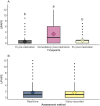Effects of assessment method (real-time versus video-recorded) on a validated pain-altered behavior scale used in castrated piglets
- PMID: 37907564
- PMCID: PMC10618161
- DOI: 10.1038/s41598-023-45869-8
Effects of assessment method (real-time versus video-recorded) on a validated pain-altered behavior scale used in castrated piglets
Abstract
We aimed to compare two assessment methodologies (real-time vs. video-recorded) using the Unesp-Botucatu Pig Composite Acute Pain Scale (UPAPS) in piglets before and after castration. Twenty-nine male piglets were castrated. Four observers scored the UPAPS over three perioperative timepoints of castration following two assessment methodologies. In real-time assessments, the observers were in-person observing the piglets in front of the pen. After two weeks, the observers did video-recorded assessments randomizing piglets and timepoints. Modeling was conducted to compare the UPAPS and each pain-altered behavior between methodologies. Intraclass correlation coefficient (ICC), Bland-Altman, and Lin's concordance correlation coefficient (CCC) were conducted to investigate agreement between methodologies. UPAPS was statistically equivalent between methodologies (P = 0.4371). The ICC for each method was very good (0.85 to 0.91). The agreement of the UPAPS assessed between methodologies had minimal bias (- 0.04), no proportion bias, and 53% of the assessments presented a perfect agreement. However, CCC of the UPAPS was moderate (0.65), and only one pain-altered behavior ("presents difficulty in overcoming obstacles or other animals") occurred more in real-time assessments (P = 0.0444). In conclusion, piglet pain assessment by UPAPS can be conducted in real-time based on a suitable agreement between the real-time and video-recorded assessment methods.
© 2023. The Author(s).
Conflict of interest statement
The authors declare no competing interests.
Figures


Similar articles
-
Less experienced observers assess piglet castration-induced acute pain differently than experienced observers: A pilot study.PLoS One. 2024 Sep 4;19(9):e0309684. doi: 10.1371/journal.pone.0309684. eCollection 2024. PLoS One. 2024. PMID: 39231102 Free PMC article.
-
Proposing a short version of the Unesp-Botucatu pig acute pain scale using a novel application of machine learning technique.Sci Rep. 2025 Feb 28;15(1):7161. doi: 10.1038/s41598-025-91551-6. Sci Rep. 2025. PMID: 40021814 Free PMC article.
-
Validation of the Unesp-Botucatu pig composite acute pain scale (UPAPS) in piglets undergoing castration.PLoS One. 2023 Apr 13;18(4):e0284218. doi: 10.1371/journal.pone.0284218. eCollection 2023. PLoS One. 2023. PMID: 37053294 Free PMC article.
-
Impact of observation duration on behavioural pain assessment and intra-observer reliability in castrated piglets: A pilot study.Anim Welf. 2025 Apr 28;34:e27. doi: 10.1017/awf.2025.22. eCollection 2025. Anim Welf. 2025. PMID: 40337298 Free PMC article.
-
Proposed multidimensional pain outcome methodology to demonstrate analgesic drug efficacy and facilitate future drug approval for piglet castration.Anim Health Res Rev. 2021 Dec;22(2):163-176. doi: 10.1017/S1466252321000141. Epub 2021 Dec 3. Anim Health Res Rev. 2021. PMID: 34859764 Review.
Cited by
-
Less experienced observers assess piglet castration-induced acute pain differently than experienced observers: A pilot study.PLoS One. 2024 Sep 4;19(9):e0309684. doi: 10.1371/journal.pone.0309684. eCollection 2024. PLoS One. 2024. PMID: 39231102 Free PMC article.
-
Proposing a short version of the Unesp-Botucatu pig acute pain scale using a novel application of machine learning technique.Sci Rep. 2025 Feb 28;15(1):7161. doi: 10.1038/s41598-025-91551-6. Sci Rep. 2025. PMID: 40021814 Free PMC article.
-
Clinical validation of the Unesp-Botucatu acute pain scale in sheep undergoing orthopedic surgery.PLoS One. 2025 May 12;20(5):e0323132. doi: 10.1371/journal.pone.0323132. eCollection 2025. PLoS One. 2025. PMID: 40354487 Free PMC article.
-
Real-time and video-recorded pain assessment in beef cattle: clinical application and reliability in young, adult bulls undergoing surgical castration.Sci Rep. 2024 Jul 2;14(1):15257. doi: 10.1038/s41598-024-65890-9. Sci Rep. 2024. PMID: 38956118 Free PMC article.
References
-
- Guatteo R, Guémené D. Sources of known and/or potential pain in farm animals. Adv. Anim. Biosci. 2014;5:319–332. doi: 10.1017/S204047001400020X. - DOI
MeSH terms
LinkOut - more resources
Full Text Sources
Medical

